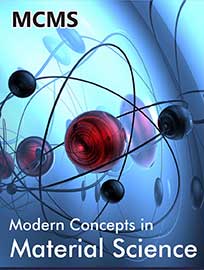 Research Article
Research Article
Study on X-Ray-Induced Defects as Barriers for Dislocation Motion by Strain-Rate Cycling Tests Combined with Ultrasonic Oscillation
Yohichi Kohzuki*
Department of Mechanical Engineering, Saitama Institute of Technology, Japan
Yohichi Kohzuki, Department of Mechanical Engineering, Saitama Institute of Technology, 1690 Fusaiji, Fukaya, Saitama 369-0293, Japan..
Received Date:April 27, 2023; Published Date:May 19, 2023
Abstract
Strain-rate cycling tests were carried out under superposition of ultrasonic oscillation during plastic deformation at 77 to 293 K for two kinds of specimens: non-irradiated and X-ray-irradiated NaBr single crystals. This method is considered to give the effective stress τp, when a dislocation begins to overcome the defects induced by the radiation in the NaBr crystal with the help of thermal activation. The relative curve of τp and temperature is fitted to the Barnett model within the temperature by numerical calculation with the parameters: τp value (1.99 MPa) at 0 K and Tc (369 K) for the crystal. Tc is the critical temperature at which τp is zero (i.e., dislocation overcomes the radiation-induced defects only with the help of thermal activation and the defects no longer act as obstacles for dislocation motion).
Keywords: Dislocation; X-ray irradiation; Effective stress; Plastic deformation; Strain rates
Introduction
The solution hardening due to the additives are caused by the mobile dislocations obstructed by the point defects around them in the crystal at low temperature. The dislocation-additive ions interaction affects the hardening of crystal. It is well known that alkali halide crystals are hardened by X-ray irradiation [1-4] and the yield stress becomes large with the irradiation dose [5]. However, the interaction between dislocation and the defect is not clearly established yet.
The results on the movement of dislocation breaking-away from impediments such as the additives [6,7] with the oscillatory stress have been obtained by the strain-rate cycling tests combined with ultrasonic oscillation. Useful information on the interaction between mobile dislocation and additive ions has been reported so far by the method during plastic deformation of alkali halide crystals [6-8]. The X-irradiation-induced defect and dislocation interaction is reported here by the method with the irradiated NaBr single crystals.
Experimental Procedure
NaBr single crystalline ingot was cleaved to the size of 5×5×15 mm3 and the specimens were subjected to the heat treatment: annealing at 973 K for 20 h and were gradually cooled to room temperature at the rate of 40 K/h for the purpose of reducing dislocation density as much as possible. The specimens were further exposed to X-ray (W-target, 30 kV, 20 mA) for 3 h on each of the pair wide surfaces at room temperature by Shimadzu XD-610. Namely, the total exposure time is 6 h.
The experimental apparatus is schematically illustrated in Figure 1. The specimens fixed on a piezoelectric transducer were compressed by a testing machine (Shimadzu DSS-500) and the ultrasonic oscillatory stress was intermittently superimposed by the resonator composed of a vibrator and a horn with the resonant frequency of 20 kHz. The strain of the specimen seems to be homogeneous, since the wavelength (166.5 mm [9]) for NaBr is approximately 11 times as long as the length of specimen.
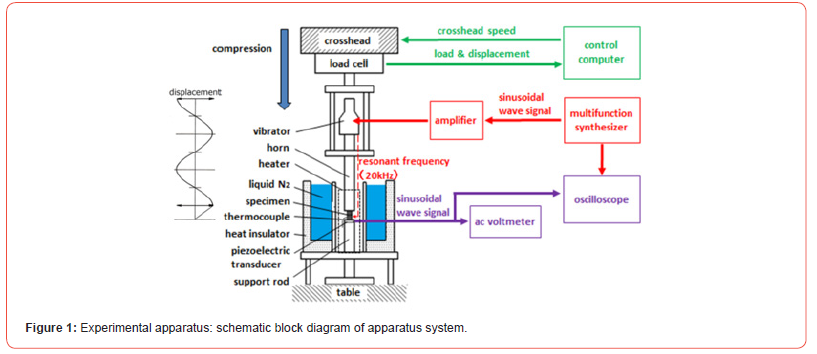
When the strain-rate cycling tests combined with ultrasonic oscillation were carried out, the variation of applied stress τa is illustrated in Figure 2. Stress change (Δτ) is caused by applying or removing ultrasonic oscillation during plastic deformation of the specimen. As the strain-rate cycling between two strain rates (1.1×10-5 and 5.5×10-5 s-1) was conducted at 77 to 293 K in the middle of the application of ultrasonic oscillation, the stress change is denoted by Δτ’ as illustrated in the figure. The strainrate sensitivity λ of flow stress was derived from the Δτ’ value (i.e.,λ = Δτ ′ Δlnε = Δτ ′ ln(ε2 ε1)).
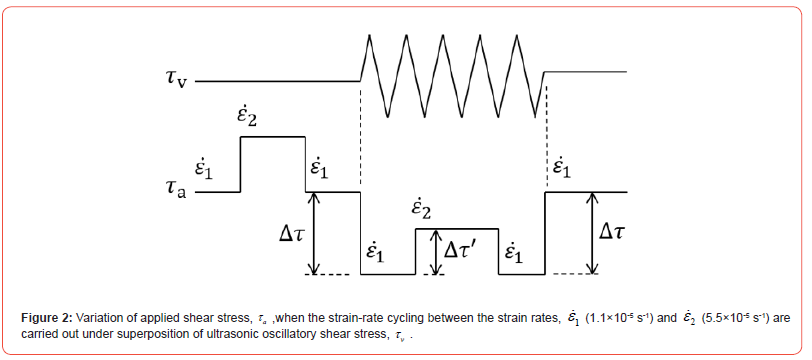
Results and Discussion
With regard to non-irradiated NaBr single crystal at 193 K, the values of Δτ and λ at strains 10, 12, and 14 % are plotted in Figure 3 as the relative curve of Δτ versus λ at a given strain. Only one bending point is on each curve. As for the X-ray-irradiated NaBr single crystal, the relative curves of Δτ versus λ at 173 and 213 K are shown in Figure 4 (a) and (b). The relative curves have stair like shape. That is to say, the first plateau place ranges below the first bending point, τp, within low Δτ and second one extends from the second bending point within high Δτ. λ decreases with Δτ between the two bending points.
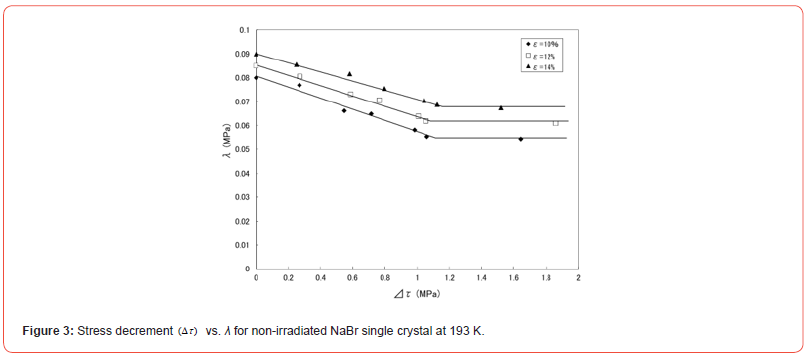
The shape of Δτ versus λ is similar to the case of NaBr:Li+ (0.5 mol%) single crystals at low temperature, which was described in the previous paper [10]. It has been reported that the length of dislocation segment increases and λ decreases when the ultrasonic oscillatory stress is applied to KCl:Br- (0.5, 1, 2 mol%) or I- (0.2, 0.5, 1 mol%) single crystals during plastic deformation at room temperature [11]. λ relates to the average length of dislocation segment pinned by obstacles. In addition, the value of τp (see Figure 4 (a)) depends on temperature and on type and concentration of dopants in alkali halide doped with monovalent or divalent ions [12,13]. Therefore, τp has been considered the effective stress due to the obstacles, when a dislocation begins to overcome the weak obstacles such as dopants which lie on the dislocation with the help of thermal activation during plastic deformation [6-8].
Although τp is not observed on the relation between Δτ and λ for the non-irradiated NaBr crystal at 193 K, τp becomes to appear on the relative curve at near the temperature by irradiating the crystal with the X-ray, as can be seen in Figure 4 (a) and (b). The weak obstacles for dislocation motion are considered the X-ray induced defects here. Accordingly, the appearance of τp in Figure 4 (a) and (b) represents the effective stress due to the defects induced by the X-irradiation.
None were added to NaBr, but a small amount of various impurities seems to contain in it. This may lead to the phenomenon that the bending point appears on Δτ versus λ curve in Figure 3 for the non-irradiated crystal.
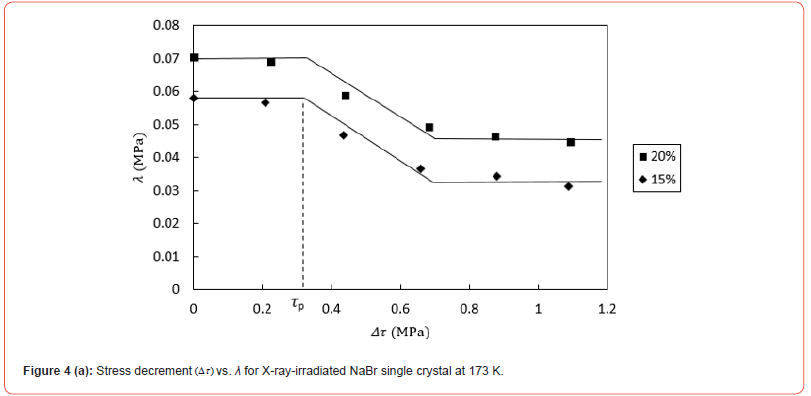
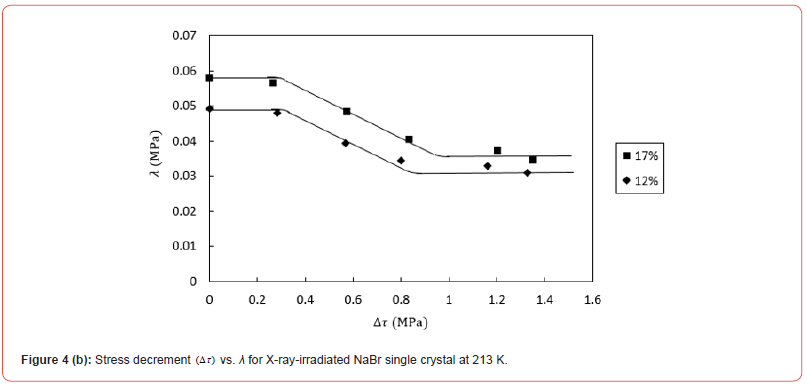
Figure 5 shows the τp-temperature relationship for the specimens and reflects the interaction between dislocation and the X-ray-induced defects. The plots (open circles) in the figure represent τp for the irradiated NaBr crystals at 77 to 293 K. τp decreases with the temperature and approaches to zero at the critical temperature Tc at which dislocation overcomes the radiation-induced defects only with the help of thermal activation and the defects no longer act as obstacles for dislocation motion. The force-distance curve between dislocation and tetragonal defect was reported by Barnett and Nix [15]. Assuming that the interaction between dislocation and the radiation-induced defect can be approximated by the Barnett model, the solid curve in Figure 5 was obtained by numerical calculation with the parameters: Tc (369 K) and τp0 (1.99 MPa). The solid curve agrees with the open circles (i.e., τp for the specimen) in Figure 5. τp0 is the value of τp at absolute zero.
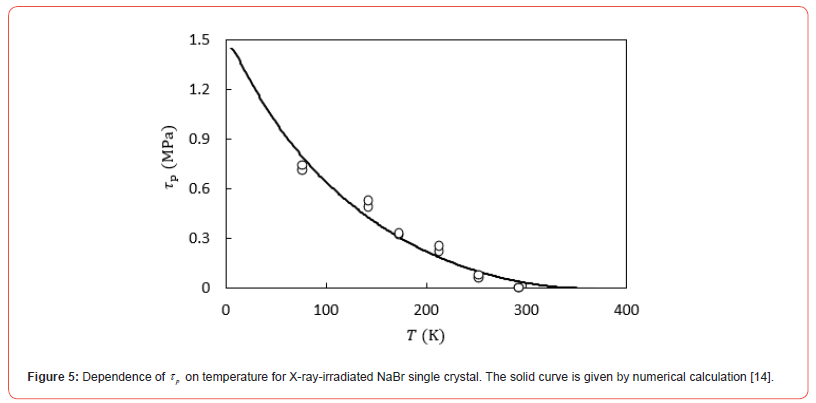
Conclusion
Non-irradiated and X-ray-irradiated NaBr single crystals were deformed by compression; during the tests strain-rate cycling was conducted under superposition of ultrasonic oscillation. The data were analyzed in terms of λ versus Δτ due to oscillation. As a result, τp is referred to the effective stress due to the X-ray-induced defects and τp versus T curve reflects the interaction between dislocation and the defects induced by the X-irradiation. Furthermore, the values of τp0 (1.99 MPa) and Tc (369 K) were estimated for the irradiated ionic crystal. The combination method of strain-rate cycling tests and ultrasonic oscillation gives useful information on dislocation- the point defects interaction in the irradiated NaBr crystal, as the case for ionic crystals doped with monovalent or divalent ions.
Acknowledgment
Dr. T. Ohgaku, as well as H. Takeno are acknowledged for his collaboration in the analysis on Δτ and λ data, as well as for his experimental assistance.
Conflict of Interest
No conflict of interest.
References
- Sibley WA, Sonder E (1963) Hardening of KCl by electron and gamma irradiation. Journal of Applied Physics 34(8): 2366-2370.
- Nadeau JS (1964) Radiation hardening in alkali-halide crystals. Journal of Applied Physics 35(4): 1248-1255.
- Reppich B (1971) Radiation hardening of alkali halides and magnesium oxide. Scripta Metallurgica 5(4): 289-293.
- Tanimura K, Fujiwara M, Okada T, Hagihara T (1978) Mechanism of low-temperature radiation hardening in alkali halides. I. Single halogen interstitials as the hardening agent at low temperature. Journal of Applied Physics 49(11): 5452-5456.
- Meshii M (1968) Interaction of glide dislocations with interstitials and lattice vacancies. In: Eyre BL editor. Proceedings of Symposium on the Interactions between Dislocations and Point Defects, Harwell, pp. 566-603.
- Kohzuki Y (2009) Study on the interaction between a dislocation and impurities in KCl:Sr single crystals by the Blaha effect-Part IV influence of heat treatment on dislocation density. Journal of Materials Science 44(2): 379-384.
- Kohzuki Y (2010) Bending angle of dislocation pinned by an obstacle and the Friedel relation. Philosophical Magazine 90(16): 2273-2287.
- Ohgaku T, Matsunaga T (2009) Interaction between dislocation and divalent impurity in KBr single crystals. IOP Conference Series: Materials Science and Engineering 3: 012021.
- Sirdeshmukh DB, Sirdeshmukh L, Subhadra KG (2001) Alkali halides. Berlin Heidelberg, Springer-Verlag, pp. 41.
- Kohzuki Y (2022) Study on thermal activation barrier for dislocation motion by strain-rate cycling tests combined with ultrasonic oscillations. Modern Concepts in Material Science 5(1): 1-4.
- Ohgaku T, Takeuchi N (1990) Study on dislocation-impurity interaction by the Blaha effect. Physica Status Solidi A 118(1): 153-159.
- Ohgaku T, Takeuchi N (1992) Interaction between a dislocation and monovalent impurities in KCl single crystals. Physica Status Solidi A 134(2): 397-404.
- Kohzuki Y, Ohgaku T, Takeuchi N (1993) Interaction between a dislocation and impurities in KCl single crystals. Journal of Materials Science 28(13): 3612-3616.
- Kohzuki Y, Ohgaku T (2017) X-ray-induced defects as obstacles to dislocation motion in alkali halide crystals. Journal of Materials Science 52(7): 3959-3966.
- Barnett DM, Nix WD (1973) The interaction force between tetragonal defects and screw dislocations in cubic crystals. Acta Metallurgica 21(8): 1157-1168.
-
Yohichi Kohzuki*. Study on X-Ray-Induced Defects as Barriers for Dislocation Motion by Strain-Rate Cycling Tests Combined with Ultrasonic Oscillation. Mod Concept Material Sci. 5(2): 2023. MCMS. MS.ID.000608.
-
: Dislocation, X-ray irradiation, Effective stress, Plastic deformation, Strain rates, Ultrasonic oscillation, Defects, Temperature, Crystals, Bending point, Effective stress, Obstacles, Interaction, Specimen
-

This work is licensed under a Creative Commons Attribution-NonCommercial 4.0 International License.



